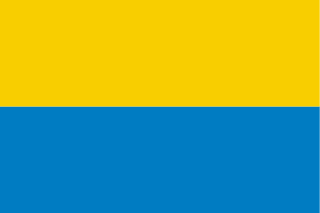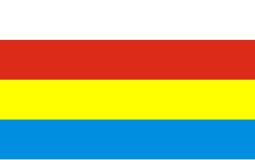
The flag of the city of Warsaw, the capital of Poland, is a bicolour rectangle, divided into two equally-sized horizontal stripes: yellow at the top, and red at the bottom. It began being used in 1938 without official status, and was officially adopted by the city, in 1991.

The civil flag of the Lublin Voivodeship, Poland, is a tricolour rectangle with three horizontal stripes — white (silver), red, and yellow (golden) — and, in its centre, the coat of arms of the voivodeship, which consists of a white (silver) male jumping cervus, with a yellow (golden) crown on its neck, placed on the red escutcheon. The cervus is facing left. The top and bottom stripes are twice the size of the middle stripe.

The coat of arms that serves as the official symbol of the Masovian Voivodeship, Poland, consists of a red escutcheon, that features a white (silver) eagle, with raised wings, and its head turned left. Its current version had been designed by Andrzej Heidrich, and adopted in 2006.

The flag of Upper Silesia serves as the symbol of the historical and geographical region of the Upper Silesia in Poland, and as one of the symbols of the Silesian people; it is divided horizontally into two stripes: yellow on the top and blue on the bottom. It originated as the flag of the Prussian Province of Upper Silesia adopted in 1920, with its colours based on the coat of arms of Upper Silesia. The flag is also popular symbol used by the Silesian Autonomy Movement and the Silesian Separatist Movement

The flag of the Kuyavian-Pomeranian Voivodeship, Poland is a tricolour rectangle, with three horizontal stripes: red, white, and black, with white stripe in the middle being twice the size of the other ones.

The civil flag of the Silesian Voivodeship, Poland is triband rectangle, divided into three horizontal stripes, that are from top to bottom: blue, yellow, and blue. The blue stripes are twice the size of the yellow middle stripe. The state flag is a blue rectangle with yellow eagle placed in its centre. It was designed by Barbara Widłak, and adopted on 11 June 2001.

The flag of the West Pomeranian Voivodeship in Poland is a triband rectangle, divided vertically in 3 stripes of white, red, and white colour, and with the coat of arms of the voivodeship in the middle. It was adopted in 2000.

The flag of the Masovian Voivodeship, Poland is a red rectangle with silver (white) eagle, with golden (yellow) beak and legs, located on the left side of the flag.

The coat of arms of Kamień County, West Pomeranian Voivodeship located in Poland, is divided horizontally into blue and white stripes, with 2 golden (yellow) crosiers and 2 red roses within blue stripe, and red Griffin with yellow claws and beak, within the white stripe. The flag of the county is a rectangle divided horizontally into white and blue stripes, with the coat of arms in the middle.

The civil flag of the Lubusz Voivodeship, Poland is a rectangle divided into 4 stripes, which are, from top to bottom, yellow (golden), white, (silver), red, and green. Top and bottom stripes are twice the size of the 2 middle stripes. The state flag features the design of the civil flag, with the coat of arms of the voivodeship placed in the centre. It was adopted on 26 June 2000.

The civil flag of the Łódź Voivodeship, Poland is a rectangle divided into five vertical stripes, which are altering between red and yellow colours. It was designed by Marek Adamczewski, and officially adopted on 25 June 2002.

The civil flag of the Opole Voivodeship, Poland is a rectangle divided into two horizontal stripes, with yellow on the top, and blue at the bottom. The top stripe is twice the size of the bottom one.

The coat of arms of the Łódź Voivodeship, Poland is an Iberian-style escutcheon with square top and rounded base. It is divided horizontally into three stripes (pales), that area from left to right: yellow (golden), red, and yellow (red), with the middle stripe being twice as big as the other stripes. It also include three charges placed in its center, with two placed next to each over, on the top of the third one. The top two charges are Kuyavian Hybrids, divided into half, into a lion and an eagle, while the bottom one is an eagle. It was designed by Marek Adamczewski, and officially adopted on 25 June 2002.

The flag of the Warmian–Masurian Voivodeship, is red with a white boundary on its top, bottom, and right sides, and with the head of a white (silver) eagle, with yellow (golden) beak, and an eye, wearing a yellow (golden) crown, located on its left side. It was adopted in 2002.

The flag of the Świętokrzyskie Voivodeship, Poland is a rectangle divided into four parts. Its left part features a yellow vertical stripe, which wight equals to 1:4 of the wight of the flag. Its right part is divided into three horizontal stripes, that are, from top to bottom: blue, white, and red. In the middle of the white stripe is placed the coat of arms of the voivodeship. The first version of the flag had been adopted in 2001, and current version is used since 2013.

The flag that serves as the symbol of the historical and geographical region of the Western Pomerania is divided horizontally into two stripes: light blue on the top and white on the bottom. It originated as the flag of the Province of Pomerania, Prussia, used from 1882 to 1935. Since 1996, it is officially recognized as the symbol of the historical region of Western Pomerania within Mecklenburg–Western Pomerania, Germany.

The coat of arms that serves as the symbol of the Świętokrzyskie Voivodeship, Poland, consists of the Iberian style escutcheon (shield), with square top and rounded base, that is divided in the 2 by 2 chessboard pattern. The top left field features a yellow patriarchal cross. The top right field features a white eagle with yellow crown, beak, legs, stripes on its wings, and a ring on its tail. The bottom left field features eight yellow six-pointed starts, placed in three rows, each with three stars, with the exception of the bottom row, that only had 2 stars, placed to the left.

The coat of arms of Sandomierz County is divided vertically into two fields, with the left field consisting of six horizontal stripes, alternating between red and white (silver) colours, and the right field featuring nine yellow (golden) six-armed stars, placed in three horizontal rows. The flag of the county divided into three vertical stripes, of blue, yellow, and blue colour, with the middle stripe being three times, and the coat of arms placed in the centre. The design was based on the historical coat of arms of the Sandomierz Voivodeship, used from 14th to 18th centuries.

The coat of arms that serves as the symbol of Podlaskie Voivodeship, Poland is divided into two horizontal red fields. The top field depicts a white eagle, and a bottom field, a knight in a white (silver) armor, sitting on a white (silver) horse with a blue saddle and shabrack, and yellow (golden) harness, standing on its back hoofs. The knight has a blue shield with a yellow (golden) cross of Lorraine on it, put on his left arm, and hold a sword in his right hand. The current design of the coat of arms was designed by Tadeusz Gajl, and adopted in 2001.



















